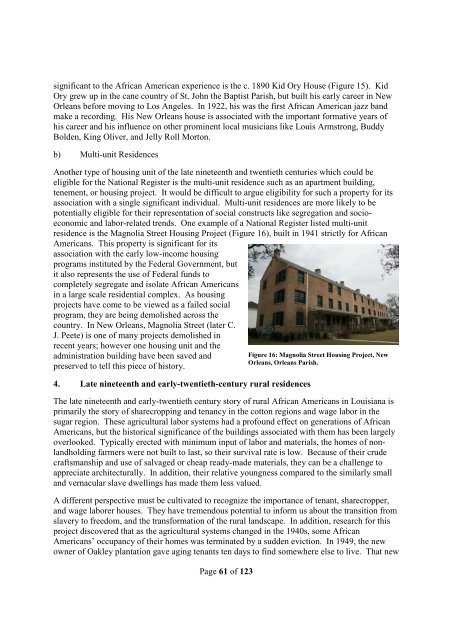The African American Experience in Louisiana
The_African_American_Experience_in_Louisiana
The_African_American_Experience_in_Louisiana
- No tags were found...
Create successful ePaper yourself
Turn your PDF publications into a flip-book with our unique Google optimized e-Paper software.
significant to the <strong>African</strong> <strong>American</strong> experience is the c. 1890 Kid Ory House (Figure 15). Kid<br />
Ory grew up <strong>in</strong> the cane country of St. John the Baptist Parish, but built his early career <strong>in</strong> New<br />
Orleans before mov<strong>in</strong>g to Los Angeles. In 1922, his was the first <strong>African</strong> <strong>American</strong> jazz band<br />
make a record<strong>in</strong>g. His New Orleans house is associated with the important formative years of<br />
his career and his <strong>in</strong>fluence on other prom<strong>in</strong>ent local musicians like Louis Armstrong, Buddy<br />
Bolden, K<strong>in</strong>g Oliver, and Jelly Roll Morton.<br />
b) Multi-unit Residences<br />
Another type of hous<strong>in</strong>g unit of the late n<strong>in</strong>eteenth and twentieth centuries which could be<br />
eligible for the National Register is the multi-unit residence such as an apartment build<strong>in</strong>g,<br />
tenement, or hous<strong>in</strong>g project. It would be difficult to argue eligibility for such a property for its<br />
association with a s<strong>in</strong>gle significant <strong>in</strong>dividual. Multi-unit residences are more likely to be<br />
potentially eligible for their representation of social constructs like segregation and socioeconomic<br />
and labor-related trends. One example of a National Register listed multi-unit<br />
residence is the Magnolia Street Hous<strong>in</strong>g Project (Figure 16), built <strong>in</strong> 1941 strictly for <strong>African</strong><br />
<strong>American</strong>s. This property is significant for its<br />
association with the early low-<strong>in</strong>come hous<strong>in</strong>g<br />
programs <strong>in</strong>stituted by the Federal Government, but<br />
it also represents the use of Federal funds to<br />
completely segregate and isolate <strong>African</strong> <strong>American</strong>s<br />
<strong>in</strong> a large scale residential complex. As hous<strong>in</strong>g<br />
projects have come to be viewed as a failed social<br />
program, they are be<strong>in</strong>g demolished across the<br />
country. In New Orleans, Magnolia Street (later C.<br />
J. Peete) is one of many projects demolished <strong>in</strong><br />
recent years; however one hous<strong>in</strong>g unit and the<br />
adm<strong>in</strong>istration build<strong>in</strong>g have been saved and<br />
preserved to tell this piece of history.<br />
4. Late n<strong>in</strong>eteenth and early-twentieth-century rural residences<br />
<strong>The</strong> late n<strong>in</strong>eteenth and early-twentieth century story of rural <strong>African</strong> <strong>American</strong>s <strong>in</strong> <strong>Louisiana</strong> is<br />
primarily the story of sharecropp<strong>in</strong>g and tenancy <strong>in</strong> the cotton regions and wage labor <strong>in</strong> the<br />
sugar region. <strong>The</strong>se agricultural labor systems had a profound effect on generations of <strong>African</strong><br />
<strong>American</strong>s, but the historical significance of the build<strong>in</strong>gs associated with them has been largely<br />
overlooked. Typically erected with m<strong>in</strong>imum <strong>in</strong>put of labor and materials, the homes of nonlandhold<strong>in</strong>g<br />
farmers were not built to last, so their survival rate is low. Because of their crude<br />
craftsmanship and use of salvaged or cheap ready-made materials, they can be a challenge to<br />
appreciate architecturally. In addition, their relative youngness compared to the similarly small<br />
and vernacular slave dwell<strong>in</strong>gs has made them less valued.<br />
A different perspective must be cultivated to recognize the importance of tenant, sharecropper,<br />
and wage laborer houses. <strong>The</strong>y have tremendous potential to <strong>in</strong>form us about the transition from<br />
slavery to freedom, and the transformation of the rural landscape. In addition, research for this<br />
project discovered that as the agricultural systems changed <strong>in</strong> the 1940s, some <strong>African</strong><br />
<strong>American</strong>s’ occupancy of their homes was term<strong>in</strong>ated by a sudden eviction. In 1949, the new<br />
owner of Oakley plantation gave ag<strong>in</strong>g tenants ten days to f<strong>in</strong>d somewhere else to live. That new<br />
Page 61 of 123<br />
Figure 16: Magnolia Street Hous<strong>in</strong>g Project, New<br />
Orleans, Orleans Parish.


